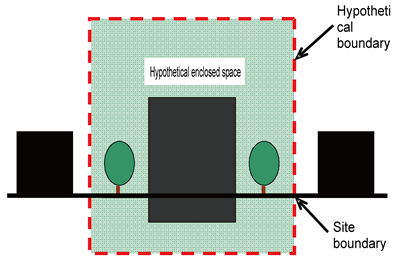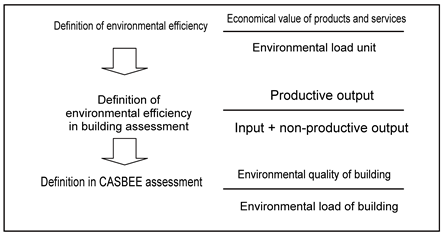|

Past
development of environmental performance assessment
(1) Stage
1
The oldest form of environmental assessment of buildings in Japan is
the performance assessment of building environments, mainly indoor environments,
which is basically aimed at improving living amenities or enhancing
convenience for occupants. This can be thought of as Stage 1 in the
evolution of the environmental assessment of buildings. At this stage,
since the local environment surrounding the building concerned and the
global environment were generally considered as open systems, environmental
assessments paid no attention to the fact that buildings simply discharged
their environmental loadings into their surroundings. In this sense,
the philosophy behind environmental assessments was very clear, but
opposite to today’s approach.
(2) Stage
2
The growth of public concern over air pollution problems or the effects
of wind on pedestrians etc. in urban areas such as Tokyo in the 1960s
led to the establishment of environmental impact assessments. This was
the time when the concept of environmental loadings was initiated and
incorporated into building environmental assessments, and this is thought
of as Stage 2. Here, only the negative effects that buildings have on
their surrounding environments, such as urban air pollution, wind damage,
and daylight obstruction etc., are considered as environmental impacts,
i.e. environmental loads. In Stage 1, the environment usually suggests
a private space or property, whereas in Stage 2 it is a public (or non-private)
space.
(3) Stage
3
Stage 3 in the evolution of the environmental assessment of buildings
began after the increase in the consciousness of global environmental
problems in the 1990's. A number of specific methods have already been
proposed, based on extensive research experience, including BREEAM,
LEEDTM and GB Tool. In recent years, building environmental
performance assessment methods such as these have spread rapidly in
society, particularly in developed countries, and they have also come
to be used for "Design for Environment" and building environmental
labeling (rating). The main issue in assessment at this stage is the
negative impacts; in other words, the environmental loadings that the
buildings have on the environment. That is to say, it considers Life
Cycle Assessment (LCA), evaluating the environmental loads of a building
throughout its life. In addition, building performance was also included
as an object in some assessments, as in Stage 1. Notably, none of the
above assessment tools clearly distinguish between these two basic assessment
objects (in Stage 1 and Stage 2). Also, the scope (or boundary) of the
assessment objects is not clearly stated. In this sense, the concept
of environmental assessment in Stage 3 lacks the clear underlying philosophy
found in Stage 1 and Stage 2, while the framework of assessment has
expanded in Stage 3. The assessment framework, relative to the first
and second stages, but conversely, the framework of assumptions on which
the environmental performance evaluation is based has become unclear.
New
Stage in the Environmental Assessment of Buildings
Development of
CASBEE started from perception that the above situation required a reconstruction
of the current environmental performance assessment framework into a
new system clearly based on the perspective of sustainability. Stage
3 in environmental assessment began when it was recognized that the
capacities of local environments, and the world as a whole, were reaching
a limit. As a result, the concept of closed ecosystems became essential
for determining environmental capacities when conducting environmental
assessments. Therefore a hypothetical enclosed space bounded by the
borders of the building site, as shown in Figure 1, is proposed here
in making environmental assessments of buildings. The on-site space
bounded by these hypothetical boundaries can be controlled by the parties
involved in the building, including the owner and planner, but the space
beyond is public (non-private) space, which is largely beyond control.
The environmental loads can thus be defined as "the negative environmental
impact that extends outside to the public environment beyond the hypothetical
enclosed space." The improvement of environmental performance within
the hypothetical enclosed space is defined as "the improvement in living
amenities for building users." Dealing with both factors, the stage
4 environmental assessment clearly defines these two factors, and distinguishes
one from the other as defined by BEE. This makes the philosophy of assessment
at stage 4 much clearer, and it has been used to form the framework
for CASBEE, and it is the basis of the CASBEE framework.

Figure
3. Hypothetical enclosed space divided by the site boundary
From
Eco-efficiency to Built Environment Efficiency (BEE)
The concept of Eco-efficiency
has been introduced for CASBEE to enable the integrated assessment of
two factors, inside and outside the building site. Eco-Efficiency is
normally defined as "Value of products and services per unit environmental
load. Efficiency is commonly defined in terms of input and output quantities,
so a new model can be proposed for an expanded definition of Eco-Efficiency,
as "(beneficial output) / (input + non-beneficial output)." As Figure
4 shows, this new model of environment efficiency can be extended to
define Built Environment Efficiency (BEE), which CASBEE uses as its
assessment indicator.

Figure
4. Development from the Eco-efficiency concept to BEE
Copyright
(C) Japan GreenBuild Council (JaGBC) / Japan Sustainable Building Consortium
(JSBC),
All Rights Reserved.
|



